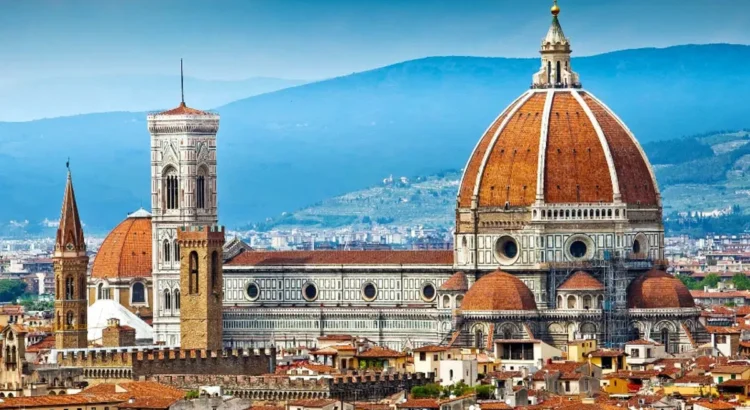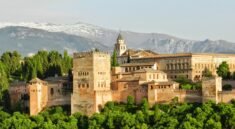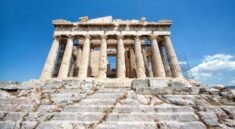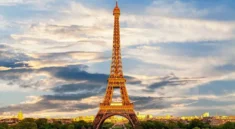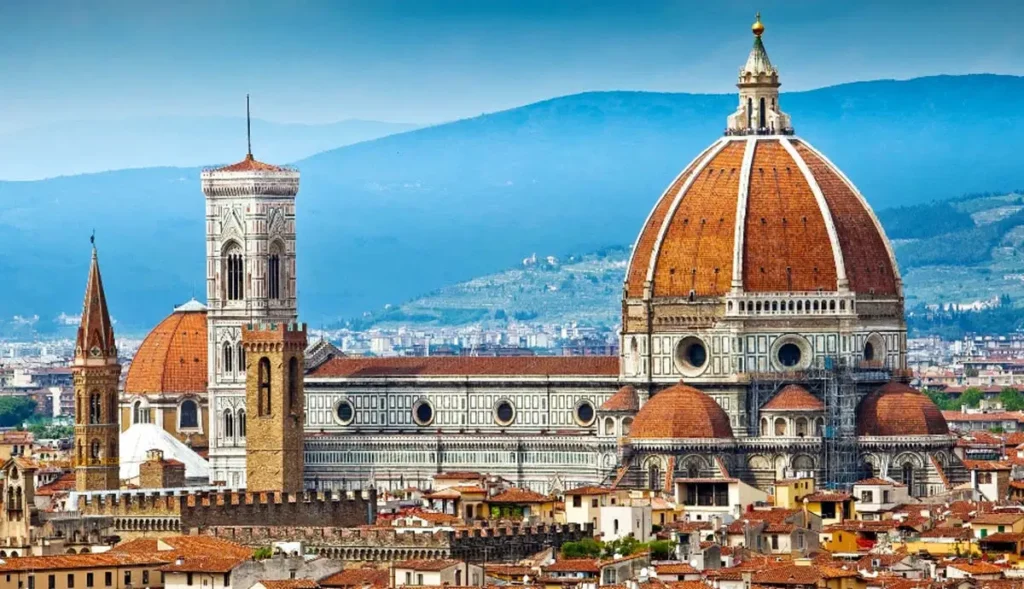
Nestled in the rolling hills of Tuscany, the city of Florence stands as a living testament to human creativity, intellect, and artistic achievement. Revered as the birthplace of the Renaissance, Florence is more than just a city—it is a cultural beacon that has illuminated the world with its art, architecture, philosophy, and innovation. Walking through its sun-dappled streets is like stepping back in time to a period when art flourished, ideas blossomed, and geniuses like Leonardo da Vinci and Michelangelo reshaped the course of history.
Florence (or Firenze in Italian) is where art met science, where classical ideals were reborn, and where some of the most iconic masterpieces in Western civilization were created. From the frescoes of the great cathedrals to the sculptures that adorn its piazzas, every corner of the city breathes life into the spirit of the Renaissance.
Let us explore the story of Florence—the birthplace of the Renaissance and the home of some of the world’s most treasured works of art.
The Renaissance: A New Dawn in Human History
The term Renaissance means “rebirth,” and it refers to a period of profound cultural revival that began in Italy during the 14th century and reached its peak in the 15th and 16th centuries. Florence was the epicenter of this movement, a place where ancient Roman and Greek ideals were rediscovered and reinterpreted through the lens of contemporary thought.
This rebirth wasn’t limited to art; it included literature, science, politics, architecture, and philosophy. At the heart of the Renaissance was humanism, the belief in the potential of human beings to think, learn, and shape their own destinies. Florence became a laboratory of innovation, a city where the power of the mind was celebrated, and the pursuit of beauty and knowledge became society’s highest callings.
The Medici: Patrons of Genius
The Renaissance in Florence would not have been possible without the powerful and influential Medici family. Originally a family of bankers, the Medici rose to political prominence and became the de facto rulers of Florence for centuries. More importantly, they were great patrons of the arts.
Lorenzo de’ Medici, known as “Lorenzo the Magnificent,” supported a host of talented artists and thinkers, including Leonardo da Vinci, Michelangelo, Botticelli, and Machiavelli. Thanks to their patronage, Florence transformed into a flourishing cultural capital where the greatest minds of the age gathered and created.
The Duomo: A Symbol of Architectural Genius
The most striking landmark in Florence is the Cattedrale di Santa Maria del Fiore, commonly known as the Duomo. Its massive red-tiled dome, designed by Filippo Brunelleschi, was a revolutionary feat of engineering and remains one of the most iconic structures in the world.
Brunelleschi’s dome was the largest ever built at the time and was constructed without the use of traditional wooden scaffolding. His innovative techniques, inspired by Roman engineering, helped define Renaissance architecture.
Inside, the cathedral is adorned with beautiful frescoes, including Giorgio Vasari’s depiction of the Last Judgment, and visitors can climb to the top of the dome for a panoramic view of Florence’s rooftops and the surrounding Tuscan countryside.
The Uffizi Gallery: A Treasure Trove of Renaissance Art
Few museums in the world can rival the Uffizi Gallery in terms of Renaissance masterpieces. Housed in a grand building originally constructed by Giorgio Vasari for the Medici, the Uffizi is a pilgrimage site for art lovers from around the world.
Its collection includes seminal works by:
- Sandro Botticelli, including The Birth of Venus and Primavera, which capture the ethereal beauty and mythological themes of the Renaissance.
- Leonardo da Vinci, whose Annunciation displays his keen eye for naturalism and composition.
- Michelangelo, whose painting Doni Tondo reveals the muscular dynamism that would characterize his later sculptures.
- Raphael, with delicate portraits that exemplify harmony and grace.
Each room in the Uffizi tells a story—not just of artistic evolution, but of a society awakening to the power of imagination and intellect.
Michelangelo: The Sculptor of the Soul
No conversation about Renaissance art is complete without Michelangelo Buonarroti, one of Florence’s most famous sons. Though his work would eventually take him to Rome, Michelangelo’s roots were deeply Florentine.
The David
Perhaps his most celebrated sculpture, David, stands proudly in the Galleria dell’Accademia. Carved from a single block of marble, David represents the biblical hero before battle—a symbol of strength, youth, and defiant humanism.
Unlike earlier depictions of David as a victorious king, Michelangelo’s version is tense, alert, and full of psychological depth. The sculpture came to symbolize Florentine freedom and civic pride, especially during times of political unrest.
Other Works
In Florence, you can also admire:
- The Medici Chapel, featuring his architectural and sculptural work in the Sagrestia Nuova.
- The Laurentian Library, where Michelangelo designed the innovative staircase and reading room.
Michelangelo’s work embodied the Renaissance ideal: a fusion of artistic excellence, human anatomy, and philosophical insight.
Florence’s Churches: Sacred Spaces of Art
Florence’s spiritual centers are also artistic marvels, housing masterpieces from the likes of Giotto, Masaccio, and Donatello.
Basilica of Santa Croce
Known as the Temple of the Italian Glories, this Franciscan church is the final resting place of Michelangelo, Galileo, Machiavelli, and Rossini. Inside, visitors can admire frescoes by Giotto and Cimabue that showcase the early transition from medieval to Renaissance art.
Basilica of San Lorenzo
Another Medici-sponsored church, San Lorenzo is where many members of the Medici family are buried. It features works by Donatello, including his unique bronze pulpit, and stunning architectural design by Brunelleschi.
Santa Maria Novella
One of the first great basilicas in Florence, this church is home to Masaccio’s Trinity, considered the first painting to employ true linear perspective, a defining technique of Renaissance art.
Piazza della Signoria: Florence’s Outdoor Gallery
As the political and civic heart of Florence, Piazza della Signoria is both a public square and an open-air museum.
Here you’ll find:
- A copy of Michelangelo’s David, standing where the original once did.
- Perseus with the Head of Medusa by Benvenuto Cellini.
- The Loggia dei Lanzi, an arched gallery filled with dynamic Renaissance sculptures.
- The imposing Palazzo Vecchio, Florence’s town hall and a symbol of its republican spirit.
This piazza is where democracy and art intertwined, where speeches were made and masterpieces unveiled, creating a living theater of cultural expression.
Renaissance Beyond Art: Florence’s Intellectual Legacy
The Renaissance wasn’t just about beautiful paintings and sculptures. Florence was also a hotbed of revolutionary thinking.
Dante and Literature
Florence was the birthplace of Dante Alighieri, author of The Divine Comedy, a literary masterpiece that bridged the medieval and modern worlds. His use of the Italian vernacular set a precedent for future writers and helped establish the Tuscan dialect as the basis of modern Italian.
Humanism and Philosophy
Philosophers like Marsilio Ficino and Pico della Mirandola championed humanist ideals. Under the patronage of the Medici, the Platonic Academy of Florence revived interest in classical Greek philosophy and helped shape Renaissance thought.
Florence Today: A City That Still Inspires
Modern Florence retains the grandeur of its Renaissance past while embracing contemporary culture. It’s a vibrant city where students, artists, historians, and travelers gather to experience the legacy of greatness.
Artisan Traditions
Florence is still a center for fine craftsmanship—from handmade leather goods and gold jewelry to paper marbling and bookbinding. These artisanal traditions date back centuries and preserve the spirit of the Renaissance in everyday life.
Contemporary Art and Museums
While historical museums dominate, Florence also boasts contemporary spaces like the Museo Novecento and modern art galleries that showcase new voices building upon the city’s storied legacy.
Planning Your Visit
- Best time to visit: Spring (April–June) and fall (September–October) offer pleasant weather and fewer crowds.
- Museum passes: Consider buying the Firenze Card to access multiple museums with skip-the-line privileges.
- Walking city: Florence is compact and walkable—ideal for wandering through its winding alleys and majestic squares.
- Cultural etiquette: Respectful attire is required in churches, and many museums and landmarks require advance booking.
Conclusion: A Timeless Masterpiece
Florence is more than a city—it is a canvas upon which human civilization painted its most profound expressions of beauty, intellect, and spirit. It is where artists turned stone into soul, where thinkers dared to challenge the cosmos, and where a vision of human potential was born.
As the birthplace of the Renaissance and a sanctuary of masterpieces, Florence continues to inspire and educate. Every brushstroke, marble carving, and architectural curve carries the echoes of a time when the world woke up from darkness and reached once more for the stars.
In Florence, the past is never just history—it is alive in the air, etched into the stone, and reflected in the eyes of everyone who comes to stand before its timeless wonders.

